AMD Radeon HD 7870 GHz Edition & Radeon HD 7850 Review: Rounding Out Southern Islands
by Ryan Smith on March 5, 2012 12:01 AM ESTCrysis: Warhead
Kicking things off as always is Crysis: Warhead. It’s no longer the toughest game in our benchmark suite, but it’s still a technically complex game that has proven to be a very consistent benchmark. Thus even four years since the release of the original Crysis, “but can it run Crysis?” is still an important question, and the answer continues to be “no.” While we’re closer than ever, full Enthusiast settings at a 60fps is still beyond the grasp of a single-GPU card.
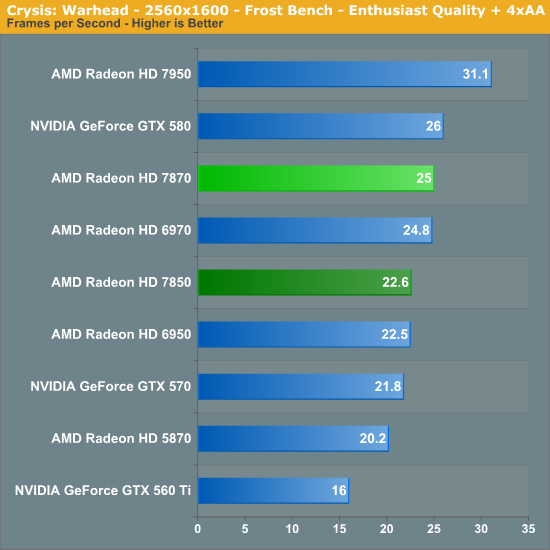
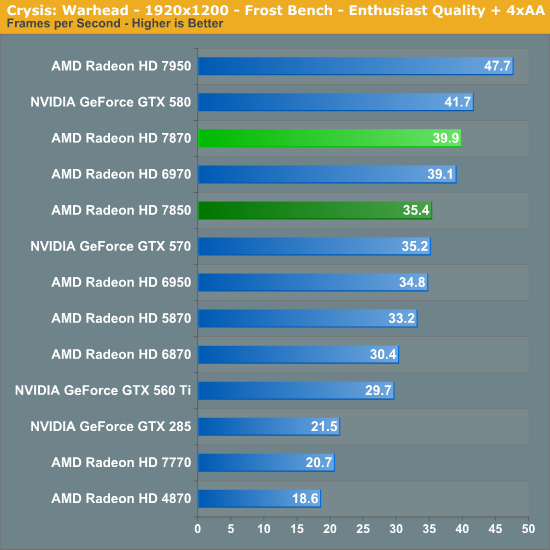
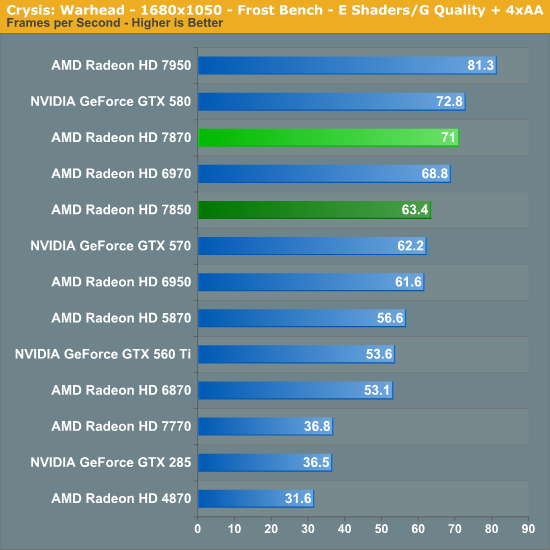
As we’ll see throughout today’s benchmarks, Crysis ends up being a good proxy for the 7800 series’ performance, especially compared to the outgoing 6900 series. Ahead of the Southern Islands launch there was some doubt that AMD could deliver 6900 series performance with the 7800 series, and this doubt increased after the 7700 series underperformed the 6800 series. Results like what we're seeing with Crysis should make it clear that the 7800 series is more than a competitor for the 6900 series, with both the 7870 and 7850 equaling or beating the 6970 and 6950 respectively in almost all tests.
Overall at 1920x1200 the 7870 gets 39.9fps, which isn’t quite enough to smoothly handle enthusiast quality and 4x MSAA. Meanwhile the 7850 is farther down the line at 35.4fps; both cards would need Crysis’s settings turned down to reach 60fps here. Compared to the 7950 the 7870 trails it by 17%, giving AMD’s next card up a fairly wide lead in this game.
Meanwhile compared to NVIDIA’s lineup the 7800 series does quite well here, reflecting the fact that the 7800 series doesn’t have a true equal in NVIDIA’s existing lineup. At 1920 the 7870 leads the GTX 570 by 12% and is within spitting distance of the GTX 580, while the 7850 is virtually tied with the more expensive GTX 570 while it leads the GTX 560 Ti by 19%. Elsewhere at 2560 the 7870 has a similar lead, while the 7850 has a 41% lead on the GTX 560 Ti; while 2560 is not the ideal resolution for either card, it’s something to keep in mind when we begin discussing the impacts of the 7800’s 2GB of RAM.
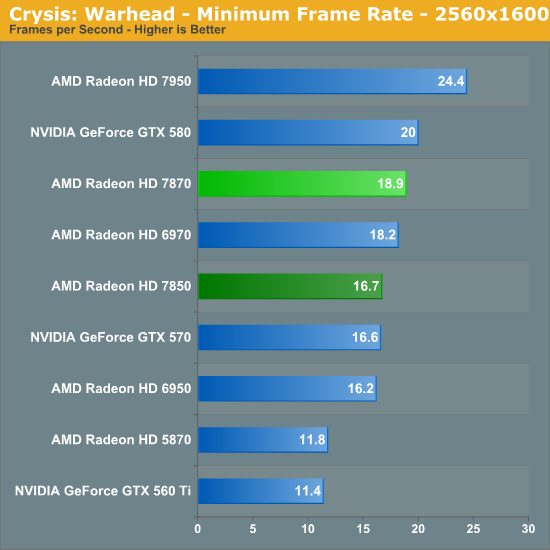
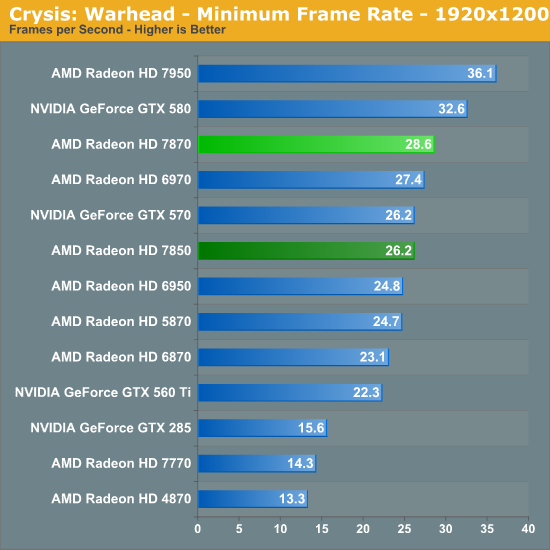
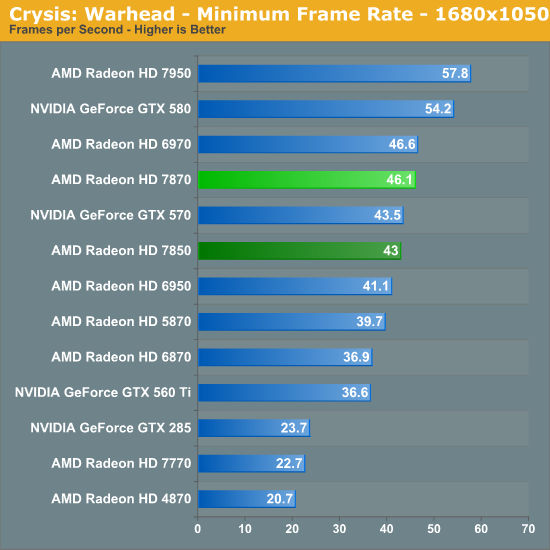
When it comes to minimum framerates in Crysis the relative rankings are nearly identical. The 7800 series extends their lead over the 6900 series by a slight degree, while the lead over NVIDIA’s cards shrinks slightly.










173 Comments
View All Comments
rburnham - Monday, March 5, 2012 - link
I tend to skip one or two generations of video cards before upgrading, but the 7850 looks like a fairly respectable upgrade over my current 6850. I love that low power draw, although I might wait until someone like MSI comes out with a quieter version.CeriseCogburn - Thursday, March 8, 2012 - link
Your 6850 is 2 watts higher power draw at idle. But you're a gamer, so load draw is important. The 7850 is 14 watts higher power draw on normal load, and 26 watts more on high load. Powertune slider only increases that.smoka - Monday, March 5, 2012 - link
A lot of people are saying power draw is not important, but it is for some of us upgrading. I have been running a GTX460 for about a year now and I'm finally thinking about jumping on the Eyefinity bandwagon. I was eying the 6950 a few weeks ago, but I decided to wait for the 78xx to come out. My plan is to move to a single card and run at a lower resolution (3072x768 or 3840x1024) until I can upgrade to a CF setup and run at 5760x1080.Also keep in mind that I have a 600W PSU, which would need an upgrade a 69xx CF or GTX570/580 SLI setup. Many people who are in the mid-high end gaming market (which the 78xx is aimed at) don't have a 1000W PSU. Upgrading to these top-tier PSUs is also another expense to add to an already expensive graphics card overhaul.
The 7870 series fits the bill exactly for me, except for the $350 price-point. I really wanted the it to be priced at $300 or less. I am hoping it will hit this price either due to brand competition, store promotion, or after kepler release.
kallogan - Monday, March 5, 2012 - link
Actually i care about power consumption more than stupid power hungry raw performance.You are not responsible citizens when buying nvidia stuff. Buy amd and save the planet.
HAHA
compvter - Monday, March 5, 2012 - link
Sure performance/price matters most, but what i find interesting in current amd generation cards is zerocore that allows me to keep my computer running with low power draw when i don't use it. I don't really care about power draw when i am using computer, but i do care about noise, and those are kind of related. Still most of the cards are silent enough for me, but most of the time my coputer is on idle (or long idle) with software running that i can't turn off (irc client), so zerocore would save me a lot of money compared to Nv offerings. Still i am interested to see what nv offers, but at the moment im considering 7870 to replace my 3870x2. Would go 79xx, but don't want to buy new case =/mattgmann - Monday, March 5, 2012 - link
save the planet...lol. Though saving on the electricity bill would be nice. The power hungry 4890 tandem in my rig surely adds a few tens of dollars a month to my bill.pieguy - Monday, March 5, 2012 - link
In the paragraph about 7800 series voltage, you mention 7950 voltages but I think you mean 7850 voltage, else I am not understanding...Also, a question about these voltages of 1.213 - 1.219. I don't know much on the subject. If these are the voltages under load, what are they actually set to (before vdroop)? If this voltage is standard for these cards, does it mean that we shouldn't be concerned about using this voltage on other 28nm 7XXX series cards for extra OC headroom and 24/7 usage? I'm just trying to figure out a max "safe" 24/7 voltage for my 7950 since the overclocking scales really well with voltage increases.
Thanks for the great review!
Ryan Smith - Monday, March 5, 2012 - link
Hi Pie, thanks for the correction. As for the voltages, those are the VIDs, so it's without vdroop. As for what a safe voltage is, there's no easy answer to that. Though 1.21v is likely safe for 7900 cards that are already in the 1.17v range.ObeseMaurice - Monday, March 5, 2012 - link
I bought a 2GB 6950 2 weeks ago for $240 and $20 mail in rebate. The 7870 is worse on all resolutions of Battlefield 3 and priced significantly higher. Very unimpressive product launch from AMD.silverblue - Monday, March 5, 2012 - link
Has anybody stopped to think how much extra performance you might get from these cards when AMD has proper drivers for them, or is this considered a moot point? Needless to say, nowhere on the BF3 benchmarks in this review is the 7870 slower than the 6950, rather it's a consistent 20% faster. Throughout the review the 7870 ranges from about 15% (Batman 1920x1200) - 70% (Civ5 1920x1200) faster depending on the title. Granted, the gap isn't always this large at 2560x1600 but it's still sizeable in a good number of cases. Are you in fact referring to the 7850?AMD are pricing these cards at that level because they can. It's certainly not going to last forever.